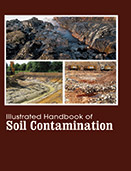Earth and Environmental Science

Soil is considered as a complex and dynamic system, containing several layers that contrast in relation to the physical, chemical, mineralogical and biological nature, which are influenced by the climate and activities of the living organisms. Soils play a critical role in delivering ecosystem services. Healthy soils are a basic prerequisite to meeting varied needs for food, biomass (energy), fiber, fodder, and other products, and to ensuring the provision of essential ecosystem services in all regions of the world. However, soil resources are facing unprecedented pressures today, many of which are human-induced. Over the past three decades, there have been marked developments in our broader understanding of humankind’s impacts on the earth, and of the frameworks with which to assess these impacts.
Illustrated Handbook of Soil Contamination introduces several innovative approaches for soil remediation and risk assessment, including advances in phytoremediation and implementation of metabolomics in soil sciences.
During the last decades of the twentieth century there was an awareness of the importance of the soil as an environmental component and recognition of the need to maintain or improve its capacity to allow it to perform its various functions. At the same time there was a confirmation that the soil is not an inexhaustible resource and, if used improperly or poorly managed, its characteristics can be lost in a short period of time, with limited opportunities for regeneration. Thus, several researches aiming to remediate the effects of the soil contaminants have been carried out worldwide. Remediation of a contaminated area involves the application of one or more techniques aiming to remove or contain harmful substances in order to allow the reuse of the area with acceptable risk limits for human and environmental health. For this purpose, an ideal remediation process must remove all the contaminants of the soil or, at least, reduce the percentage of contamination of the environment to acceptable limits; should also avoid the migration of contaminants to other areas. For the remediation of soils contaminated with petroleum and heavy metals, several physical, chemical and biological techniques have been developed for the removal or degradation in situ or ex situ of the pollutant.
In this context, this Illustrated Handbook of Soil Contamination aims to provide a thorough revision of techniques for the removal or degradation of the pollutants as well as a discussion on the implementation of such techniques for the development of remediation strategies and policies.
Soil contaminants may be responsible for health effects costing millions of euros, but studies to quantify the true cost are in their infancy. Health problems from cancers (arsenic, asbestos, dioxins), to neurological damage and lower IQ (lead, arsenic), kidney disease (lead, mercury, cadmium), and skeletal and bone diseases (lead, fluoride,
cadmium) are serious issues, that in many cases we have yet to address. Heavy metals and persistent organic chemicals are of particular concern. Human activity introduces heavy metals (such as cadmium, arsenic and mercury) to our soils through mining, smelting, industry, agriculture and burning fossil fuels.